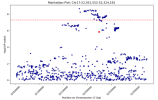hotblack
Senior Member (Voting Rights)
Thanks, very useful! So you still have the issues @forestglip outlined above?Whole genome sequencing would still be looking at SNPs—the main difference is that GWAS arrays look at a finite amount of locations in the genome and then the rest is inferred, whereas whole genome sequences are (ideally) capturing everything. But whole genome analysis would have similar limitations of trying to infer which SNPs are impacting which genes.
It’s a complicated subject! I’ve had quite a bit of GWAS exposure and still am learning a lot from this paper and discussion.
I thought I read somewhere that SNPs where defined as when an allele was present in greater than 1% of the population? And so it was that which defined what locations were on the arrays used, because they’re common variations. Although I’ve always been confused about the ‘why these locations’ question for this limited sequencing versus whole genome sequencing.



